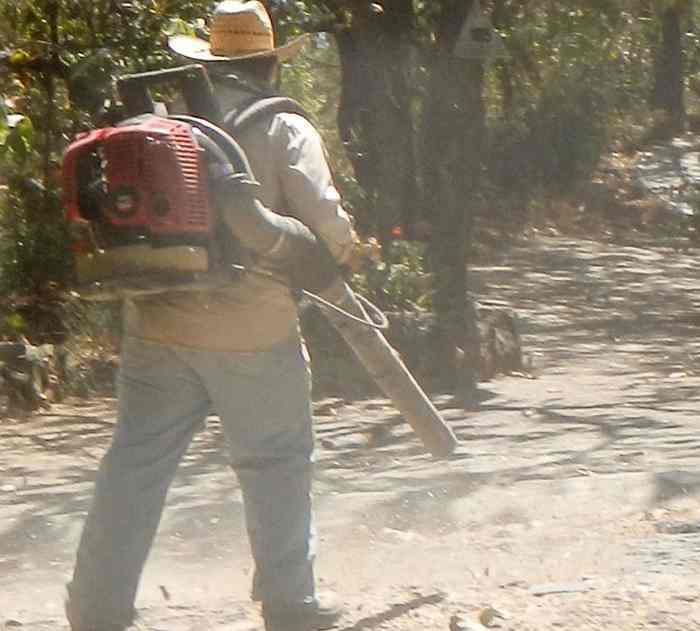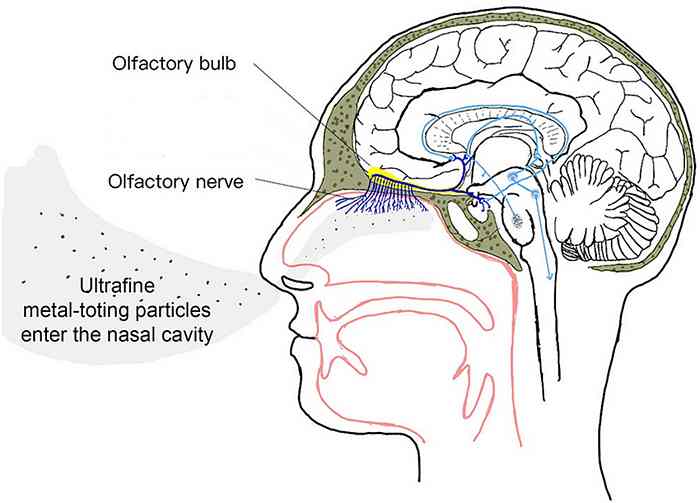Studies show leaf blowers pose unexpected
health hazards, especially for Mexico

Mexican kids: what is in the air
they’re breathing and what is their future? Photo: John Pint
By John Pint
A recent analysis by the Icahn School of Medicine at Mount Sinai
Hospital in New York City indicates that the air and noise pollution
from gas leaf blowers (GLBs) seriously impact respiratory health and
are also associated with problems like cancer, heart disease and
dementia—and that children, in particular, are highly susceptible to
these hazards.
A separate study shows how extremely tiny particles of metal from small
gas engines can be carried directly to the brain via the olfactory
nerve, producing the features of autism, attention-deficit disorder,
and schizophrenia.
These studies suppose seasonal use of GLBs to blow leaves off paths,
not the heavy and frequent use now in vogue throughout Mexico.

The
toxic cloud from a leaf blower can remain in the air for hours or even
days.
The Mount Sinai scientists point out that GLB combustion engines are of
extremely low efficiency; 30% of the gas and oil they use is unburned
and released directly to the atmosphere. They cite the estimate of the
California Air Resources board that operation of a GLB for one hour
releases emissions equivalent to driving a car for 15 hours or 1,100
miles.
The GLB emissions include carbon monoxide, formaldehyde, benzene, and
extremely small fragments of metal (less than 50 nanometers) from the
combustion chamber. When these are mixed with particulate matter blown
off the ground, the result is a toxic cloud which can remain suspended
in the air for up to 5 hours.
Fine particles lifted off the ground and into the air may include mold,
pesticides, pollen and heavy metals as well as the excrement of birds,
bats, dogs and cats.
To this must be added a noise level of more than 100 decibels, the
equivalent to a jackhammer or a jet taking off, a level that eventually
leads to irreparable hearing loss. Not only that, points out Mt.
Sinai's Dr. Sarah Evans, chronic noise exposure has been shown to
increase your risk of cardiovascular disease, anxiety and depression,
and impaired focus and cognition.
When the leaf blower appeared on the market in the 1980s, some Mexicans
saw it as an easy way to carry on an old custom of washing the street
outside one’s door early each morning,
That tradition has deep, preHispanic roots. It is said that the city of
Tenochtitlán had a team of a thousand men to sweep and wash its streets
every single day. This preoccupation with the look of the ground
outside your door is still around today, but some people have
replaced brooms, buckets and water with a machine that seems to do the
job quicker, without realizing that this same device throws extremely
tiny particles into the air, particles 30 percent smaller than the
width of a human hair.

Tenochtitlán
as Diego River imagined it. A thousand workers cleaned the streets
every day
The fine particles remain airborne for long periods of time,
infiltrating buildings. What these microscopic specks do to you, once
they reach your nose is something that has become of great concern to
researchers.
In the second study—included in the Proceedings of the National Academy
of Sciences—neurotoxicologist Deborah Cory-Slechta at the University of
Rochester in New York. states that these tiny particles can go up the
nose and be carried straight to the brain via the olfactory nerve,
bypassing the blood-brain barrier.
Unfortunately, these nanofragments don't travel alone.
On their surfaces the particles carry contaminants, from dioxins and
other chemical compounds, to metals such as iron and lead. “Particulate
matter may be acting as a vector,” says Masashi Kitazawa, a molecular
neurotoxicologist at the University of California, Irvine. “It might be
a number of chemicals that get into the brain and act in different ways
to cause damage. Ultrafine particles are like little Trojan horses.
Pretty much every metal known to humans is on these."

Tiny
particles of metal from leaf blowers enter the brain via the olfactory
nerve. Image after Wang et al.
Metal-toting particles that reach the brain can directly damage
neurons, says Cory-Slechta. “Both the particles themselves and their
toxic hitchhikers can also cause widespread harm by dysregulating the
activation of microglia, the immune cells in the brain. Microglia may
mistake the intruders for pathogens, releasing chemicals to try to kill
them. Those chemicals can accumulate and trigger inflammation. And
chronic inflammation in the brain has been implicated in
neurodegeneration.”
In January 2010, Cory-Slechta received a surprising request from some
University of Rochester environmental medicine colleagues. Typically,
the group researched the effects of air pollution on the lungs and
hearts of adult animals. But they had just exposed a group of newborn
mice and asked Cory-Slechta’s team to look at the brains.
At first she didn’t think much of the request. Cory-Slechta was much
more concerned about deadly lead exposure in children, her research
focus at the time. “I didn’t think of air pollution as a big problem
for the brain,” she says. Then she examined the animals’ tissue. “It
was eye-opening. I couldn’t find a brain region that didn't have some
kind of inflammation.”
Her team followed up with their own studies. In addition to
inflammation, they saw classic behavioral and biochemical features of
autism, attention-deficit disorder, and schizophrenia in mice exposed
to pollutants during the first days after birth.

Continuity:
The plaza of Teuchitlán is swept with a kind of broom that has been
used in Mexico for centuries.
Based on MRI scans, cognitive tests, and measures of inflammatory
markers in the blood, the team identified neuroinflammation, brain
structure changes, cognitive deficits, and Alzheimer’s-like pathologies
in apparently healthy children living in Mexico City, compared with a
group of similar children in a less polluted city. The findings,
according to the authors, suggested that dirty air may spur brain
disease at far younger ages than previously suspected.
If you don’t live in Mexico City, you can still experience plenty of
the bad effects of air pollution simply by opening the window wide when
your neighbor turns on his leaf blower.

"No leaf blower for me!"
says Valentina Ramírez of Guadalajara
Text and Photos © 2023 by John & Susy Pint unless
otherwise indicated.
HOME
|